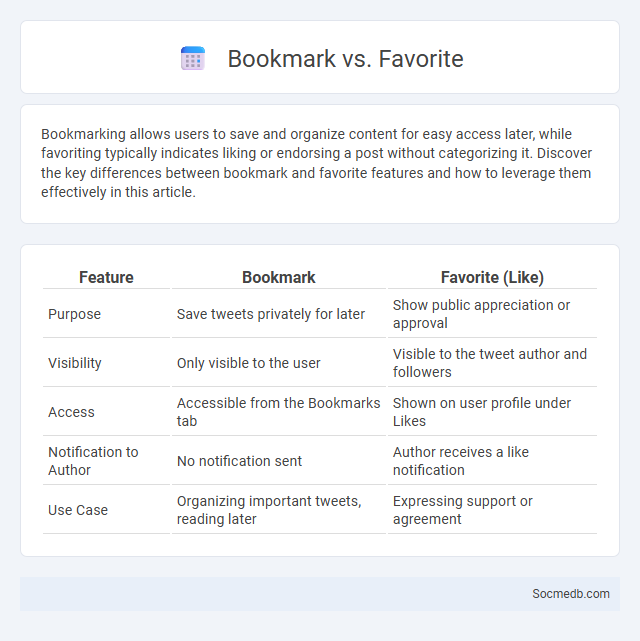
Photo illustration: Bookmark vs Favorite
Bookmarking allows users to save and organize content for easy access later, while favoriting typically indicates liking or endorsing a post without categorizing it. Discover the key differences between bookmark and favorite features and how to leverage them effectively in this article.
Table of Comparison
| Feature | Bookmark | Favorite (Like) |
|---|---|---|
| Purpose | Save tweets privately for later | Show public appreciation or approval |
| Visibility | Only visible to the user | Visible to the tweet author and followers |
| Access | Accessible from the Bookmarks tab | Shown on user profile under Likes |
| Notification to Author | No notification sent | Author receives a like notification |
| Use Case | Organizing important tweets, reading later | Expressing support or agreement |
Introduction to Bookmarks and Favorites
Bookmarks and favorites are essential tools for organizing and quickly accessing important social media content. Users can save posts, profiles, or pages to revisit later, enhancing their browsing efficiency on platforms like Facebook, Instagram, and Twitter. This feature improves user experience by enabling personalized content management and streamlined navigation.
Defining Bookmarks: Purpose and Use
Bookmarks in social media serve as a tool for users to save and organize posts, articles, videos, or other content for easy retrieval and future reference. Platforms like Instagram, Twitter, and Facebook offer bookmark features that enhance user experience by enabling personalized content curation and quick access to important or interesting information. Effective use of bookmarks increases engagement by allowing users to revisit and share valuable content without searching through feeds.
Understanding Favorites: Meaning and Function
Favorites on social media are a key feature that allows users to mark content they appreciate or want to revisit, signaling preference and engagement. This function enhances user interaction by enabling personalized content curation and facilitating easier access to valued posts. Understanding favorites helps businesses and creators analyze audience interest and tailor their strategies for improved reach and connection.
Key Differences: Bookmark vs Favorite
Bookmarks on social media primarily serve as private tools for users to save posts or content for later reference, whereas Favorites often involve publicly endorsing or highlighting content. Bookmarks allow users to organize saved items discreetly without alerting the content creator, while Favorites typically generate notifications and are visible to followers, signaling approval or interest. This distinction impacts user engagement dynamics, influencing content visibility and social interactions on platforms like Twitter and Instagram.
Browser-Specific Terminology Explained
Different browsers use unique terms to describe social media features, enhancing user navigation and interaction; Chrome refers to bookmarked pages as "favorites," while Firefox labels them "bookmarks." Your browser's terminology impacts how you save content, manage notifications, and customize settings within various social media platforms. Understanding these distinctions helps optimize your social media experience by aligning actions with familiar browser-specific language.
How Bookmarks Work Across Platforms
Bookmarks on social media platforms allow you to save posts, videos, or articles for easy access later, creating a personalized collection tailored to your interests. These saved items are usually private and synced across devices, so your bookmarks on mobile apps, desktops, or tablets remain consistent and easily retrievable. Understanding how bookmarks work across platforms ensures you can efficiently organize and revisit your favorite content anytime you want.
How Favorites Differ by Browser
Favorites, or bookmarks, differ significantly across browsers due to variations in syncing capabilities, storage formats, and integration with user accounts. Chrome stores favorites using Google synchronization, enabling seamless access across devices, while Firefox uses a unique JSON-based system tied to Firefox Accounts for cross-device syncing. Your choice of browser impacts how easily you can manage and transfer favorites, influencing your overall browsing efficiency and data accessibility.
Organizing Your Online Content: Best Practices
Organizing your online content on social media enhances visibility and engagement by using clear categories, consistent hashtags, and scheduled posting times. Leveraging metadata and descriptive captions improves searchability and user experience. You can streamline content management tools to monitor performance and adapt strategies effectively.
Advantages and Disadvantages of Each Option
Social media platforms like Facebook, Instagram, Twitter, and LinkedIn each offer unique advantages and disadvantages based on user needs. Facebook provides robust community building and detailed ad targeting but faces criticism for privacy concerns and misinformation spread. Instagram excels in visual content engagement ideal for brands, yet may encourage superficial interactions, while Twitter offers real-time news and concise communication but is prone to harassment and echo chambers; LinkedIn supports professional networking and job searching but can feel overly formal and less interactive. Understanding these trade-offs helps you choose the platform that best aligns with your social and business objectives.
Choosing Between Bookmark and Favorite: Which is Right for You?
Choosing between bookmarking and favoriting on social media depends on personal organization and content retrieval preferences. Bookmarking allows users to save links with customizable folders for easy access and categorization, ideal for managing vast amounts of information. Favoriting, often signaling approval or interest, provides a quick, visible way to endorse content while also saving it for later reference.
 socmedb.com
socmedb.com